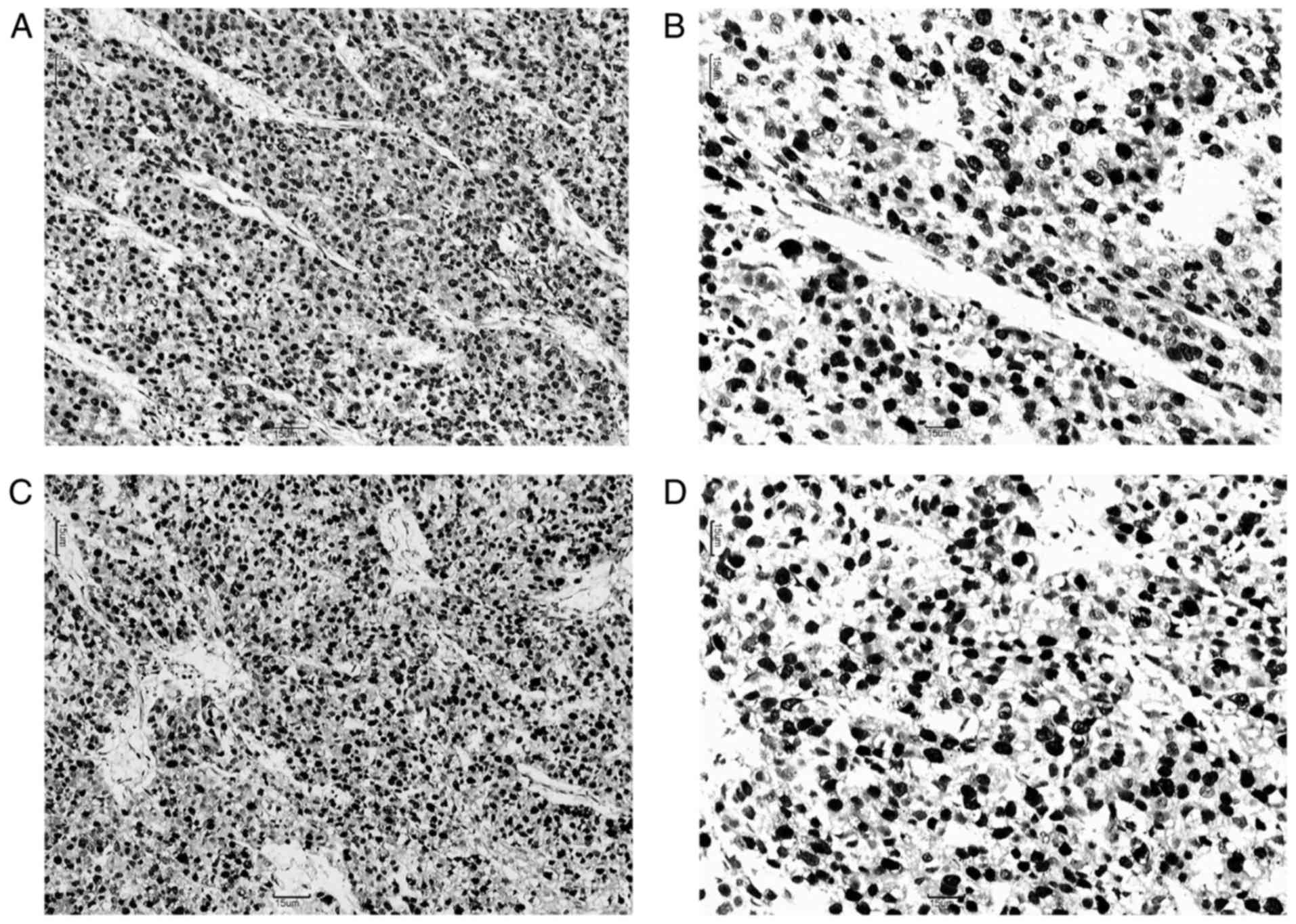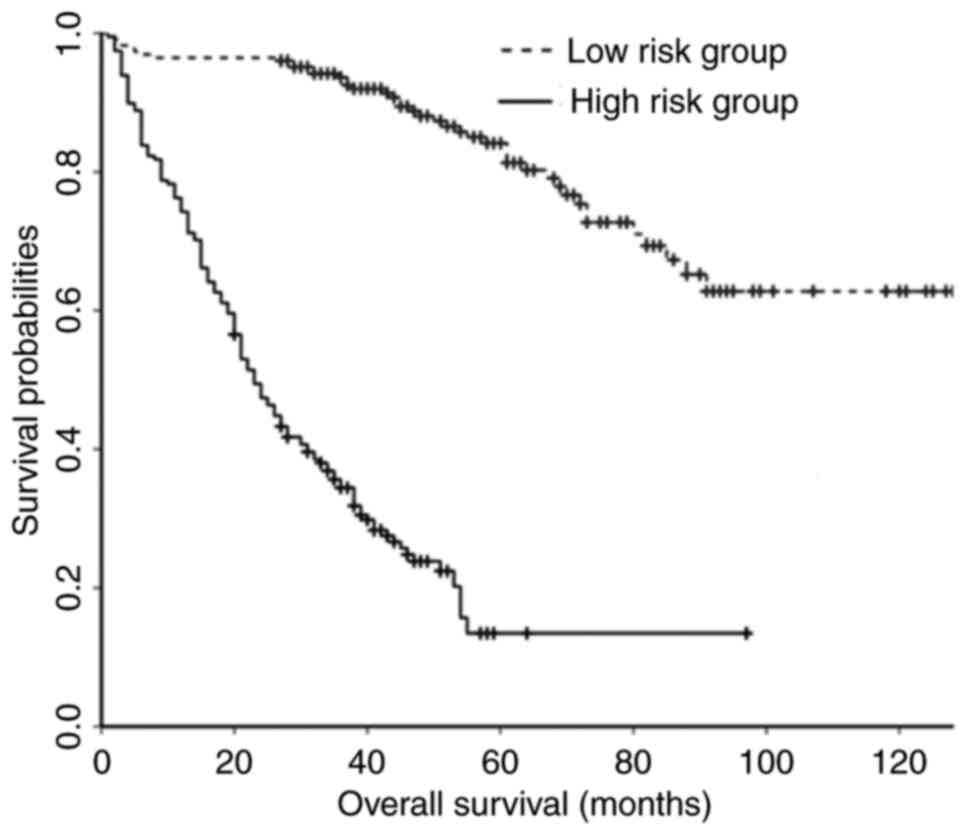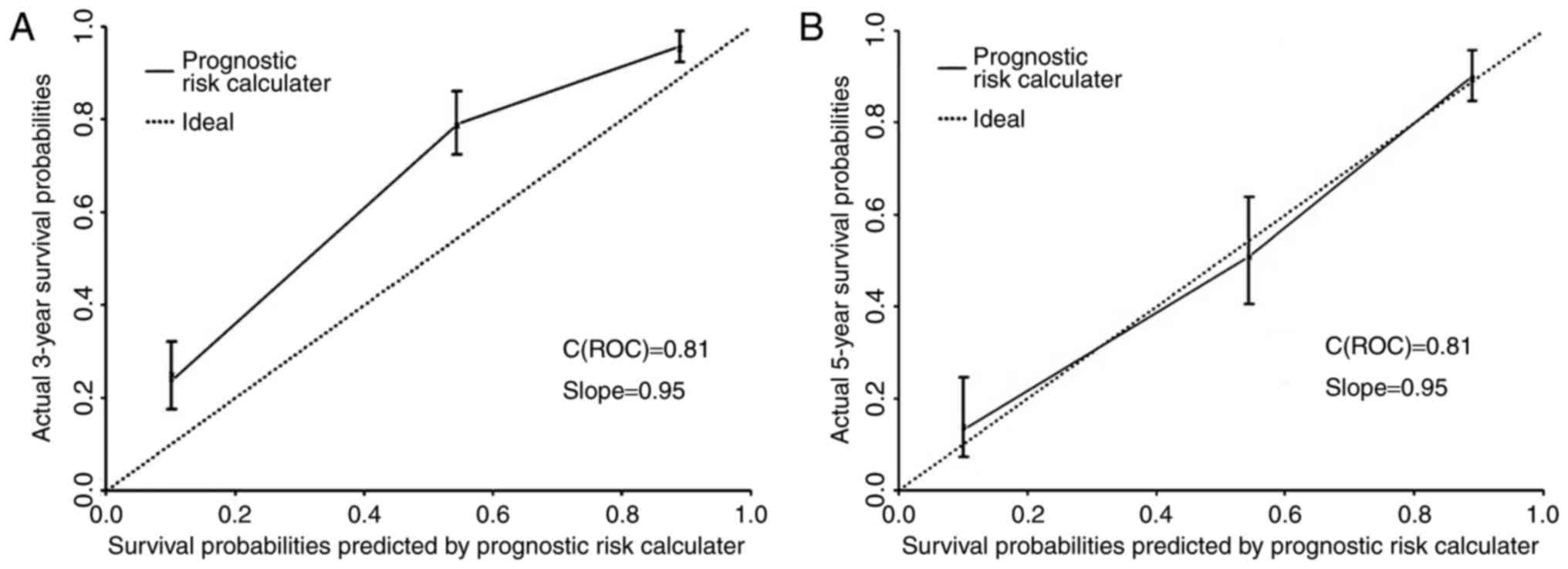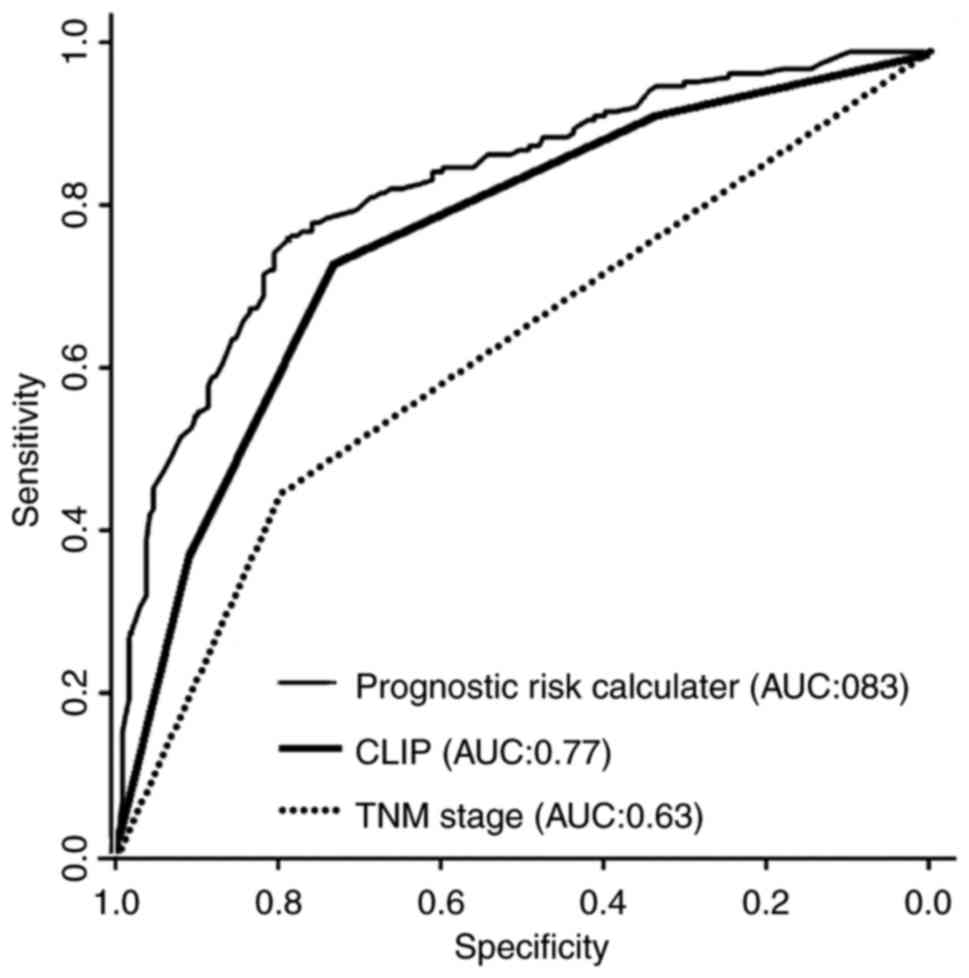|
1
|
Stewart BW and Wild CP: World cancer
report 2014International agency for research on cancer. World
Health Organization; 2014, View Article : Google Scholar
|
|
2
|
Amarapurkar D, Han KH, Chan HL and Ueno Y:
Asia-Pacific Working Party on Prevention of Hepatocellular
Carcinoma: Application of surveillance programs for hepatocellular
carcinoma in the Asia-Pacific region. J Gastroenterol Hepatol.
24:955–961. 2009. View Article : Google Scholar : PubMed/NCBI
|
|
3
|
Earl TM and Chapman WC: Hepatocellular
carcinoma: Resection versus transplantation. Semin Liver Dis.
33:282–292. 2013. View Article : Google Scholar : PubMed/NCBI
|
|
4
|
Fan ST, Lo Mau C, Poon RT, Yeun C, Liu
Leung C, Yuen WK, Lam Ming C, Ng KK and Chan Ching S: Continuous
improvement of survival outcomes of resection of hepatocellular
carcinoma: A 20-year experience. Ann Surg. 253:745–758. 2011.
View Article : Google Scholar : PubMed/NCBI
|
|
5
|
Okamura Y, Sugiura T, Ito T, Yamamoto Y,
Ashida R, Mori K and Uesaka K: Neutrophil to lymphocyte ratio as an
indicator of the malignant behaviour of hepatocellular carcinoma.
Br J Surg. 103:891–898. 2016. View Article : Google Scholar : PubMed/NCBI
|
|
6
|
Li X, Chen ZH, Xing YF, Wang TT, Wu DH,
Wen JY, Chen J, Lin Q, Dong M, Wei L, et al: Platelet-to-lymphocyte
ratio acts as a prognostic factor for patients with advanced
hepatocellular carcinoma. Tumour Biol. 36:2263–2269. 2015.
View Article : Google Scholar : PubMed/NCBI
|
|
7
|
Pinato D, North BV and Sharma R: A novel,
externally validated inflammation-based prognostic algorithm in
hepatocellular carcinoma: The prognostic nutritional index (PNI).
Br J Cancer. 106:1439–1445. 2012. View Article : Google Scholar : PubMed/NCBI
|
|
8
|
Lee YL, Li WC, Tsai TH, Chiang HY and Ting
CT: Body mass index and cholesterol level predict surgical outcome
in patients with hepatocellular carcinoma in taiwan-a cohort study.
Oncotarget. 7:22948–22959. 2016. View Article : Google Scholar : PubMed/NCBI
|
|
9
|
El Zawahry H, Nasar H, Mourad M, Zaky R
and Samie AA: P-107Topoisomerase II Alpha (TopoIIα) As A Prognostic
Biomarker In Hepatocellular Carcinoma. Ann Oncol. 26:iv302015.
View Article : Google Scholar
|
|
10
|
Luo Y, Ren F, Liu Y, Shi Z, Tan Z, Xiong
H, Dang Y and Chen G: Clinicopathological and prognostic
significance of high Ki-67 labeling index in hepatocellular
carcinoma patients: A meta-analysis. Int J Clin Exp Med.
8:10235–10247. 2015.PubMed/NCBI
|
|
11
|
Easson EC: TNM classification of malignant
tumours. Br J Cancer. 30:101–102. 1974. View Article : Google Scholar
|
|
12
|
Llovet JM and Bruix J: Prospective
validation of the cancer of the liver italian program (CLIP) score:
A new prognostic system for patients with cirrhosis and
hepatocellular carcinoma. Hepatology. 32:678–680. 2000. View Article : Google Scholar : PubMed/NCBI
|
|
13
|
Sobin LH: TNM: Evolution and relation to
other prognostic factors. Semin Surg Oncol. 21:3–7. 2003.
View Article : Google Scholar : PubMed/NCBI
|
|
14
|
Shim JH, Jun MJ, Han S, Lee YJ, Lee SG,
Kim KM, Lim YS and Lee HC: Prognostic nomograms for prediction of
recurrence and survival after curative liver resection for
hepatocellular carcinoma. Ann Surg. 261:939–946. 2015. View Article : Google Scholar : PubMed/NCBI
|
|
15
|
Li Y, Xia Y, Li J, Wu D, Wan X, Wang K, Wu
M, Liu J, Lau WY and Shen F: Prognostic nomograms for pre-and
postoperative predictions of long-term survival for patients who
underwent liver resection for huge hepatocellular carcinoma. J Am
Coll Surg. 221:962–974.e4. 2015. View Article : Google Scholar : PubMed/NCBI
|
|
16
|
Yang P, Qiu J, Li J, Wu D, Wan X, Lau WY,
Yuan Y and Shen F: Nomograms for pre-and postoperative prediction
of long-term survival for patients who underwent hepatectomy for
multiple hepatocellular carcinomas. Ann Surg. 263:778–786. 2016.
View Article : Google Scholar : PubMed/NCBI
|
|
17
|
Repetto L, Fratino L, Audisio R A,
Venturino A, Gianni W, Vercelli M, Parodi S, Lago Dal D, Gioia F,
Monfardini S, et al: Comprehensive geriatric assessment adds
information to Eastern cooperative oncology group performance
status in elderly cancer patients: An Italian group for geriatric
oncology study. J Clin Oncol. 20:494–502. 2002. View Article : Google Scholar : PubMed/NCBI
|
|
18
|
Zhou L, Rui JA, Zhou WX, Wang SB, Chen SG
and Qu Q: Edmondson-Steiner grade: A crucial predictor of
recurrence and survival in hepatocellular carcinoma without
microvascular invasio. Pathol Res Pract. 213:824–830. 2017.
View Article : Google Scholar : PubMed/NCBI
|
|
19
|
Schmilovitz-Weiss H, Tobar A, Halpern M,
Levy I, Shabtai E and Ben-Ari Z: Tissue expression of squamous
cellular carcinoma antigen and Ki67 in hepatocellular
carcinoma-correlation with prognosis: A historical prospective
study. Diagn Pathol. 6:1212011. View Article : Google Scholar : PubMed/NCBI
|
|
20
|
Kinoshita A, Onoda H, Imai N, Iwaku A,
Oishi M, Fushiya N, Koike K, Nishino H and Tajiri H: Comparison of
the prognostic value of inflammation-based prognostic scores in
patients with hepatocellular carcinoma. Br J Cancer. 107:988–993.
2012. View Article : Google Scholar : PubMed/NCBI
|
|
21
|
Cillo U, Vitale A, Grigoletto F, Farinati
F, Brolese A, Zanus G, Neri D, Boccagni P, Srsen N, D'Amico F, et
al: Prospective validation of the Barcelona clinic liver cancer
staging system. J Hepatol. 44:723–731. 2006. View Article : Google Scholar : PubMed/NCBI
|
|
22
|
Thuluvath PJ: Vascular invasion is the
most important predictor of survival in HCC, but how do we find it?
J Clin Gastroenterol. 43:101–102. 2009. View Article : Google Scholar : PubMed/NCBI
|
|
23
|
Yang L, Xu J, Ou D, Wu W and Zeng Z:
Hepatectomy for huge hepatocellular carcinoma: Single institute's
experience. World J Surg. 37:2189–2196. 2013. View Article : Google Scholar : PubMed/NCBI
|
|
24
|
Lim KC, Chow PK, Allen JC, Chia GS, Lim M,
Cheow PC, Chung AY, Ooi LL and Tan SB: Microvascular invasion is a
better predictor of tumor recurrence and overall survival following
surgical resection for hepatocellular carcinoma compared to the
Milan criteria. Ann Surg. 254:108–113. 2011. View Article : Google Scholar : PubMed/NCBI
|
|
25
|
Oishi K, Itamoto T, Amano H, Fukuda S,
Ohdan H, Tashiro H, Shimamoto F and Asahara T: Clinicopathologic
features of poorly differentiated hepatocellular carcinoma. J Surg
Oncol. 95:311–316. 2007. View Article : Google Scholar : PubMed/NCBI
|
|
26
|
Hanahan D and Weinberg RA: Hallmarks of
cancer: The next generation. Cell. 144:646–674. 2011. View Article : Google Scholar : PubMed/NCBI
|
|
27
|
Fu YP, Ni XC, Yi Y, Cai XY, He HW, Wang
JX, Lu ZF, Han X, Cao Y, Zhou J, et al: A novel and validated
inflammation-based score (IBS) predicts survival in patients with
hepatocellular carcinoma following curative surgical resection: A
STROBE-compliant article. Medicine (Baltimore). 95:e27842016.
View Article : Google Scholar : PubMed/NCBI
|
|
28
|
Proctor MJ, Morrison DS, Talwar D, Balmer
SM, Fletcher CD, O'Reilly DS, Foulis AK, Horgan PG and McMillan DC:
A comparison of inflammation-based prognostic scores in patients
with cancer. A Glasgow Inflammation Outcome Study. Eur J Cancer.
47:2633–2641. 2011. View Article : Google Scholar : PubMed/NCBI
|
|
29
|
Kinoshita A, Onoda H, Imai N, Nishino H
and Tajiri H: C-reactive protein as a prognostic marker in patients
with hepatocellular carcinoma. Hepatogastroenterology. 62:966–970.
2015.PubMed/NCBI
|
|
30
|
Watt PM and Hickson ID: Structure and
function of type II DNA topoisomerases. Biochem J. 303:681–695.
1994. View Article : Google Scholar : PubMed/NCBI
|
|
31
|
Wendorff TJ, Schmidt BH, Heslop P, Austin
CA and Berger JM: The structure of DNA-bound human topoisomerase II
alpha: Conformational mechanisms for coordinating inter-subunit
interactions with DNA cleavage. J Mol Biol. 424:109–124. 2012.
View Article : Google Scholar : PubMed/NCBI
|
|
32
|
Ali Y and Hamid Abd S: Human topoisomerase
II alpha as a prognostic biomarker in cancer chemotherapy. Tumour
Biol. 37:47–55. 2016. View Article : Google Scholar : PubMed/NCBI
|
|
33
|
Panvichian R, Tantiwetrueangdet A,
Angkathunyakul N and Leelaudomlipi S: TOP2A amplification and
overexpression in hepatocellular carcinoma tissues. Biomed Res Int.
2015:3816022015. View Article : Google Scholar : PubMed/NCBI
|
|
34
|
Watanuki A, Ohwada S, Fukusato T, Makita
F, Yamada T, Kikuchi A and Morishita Y: Prognostic significance of
DNA topoisomerase IIalpha expression in human hepatocellular
carcinoma. Anticancer Res. 22:1113–1119. 2001.
|
|
35
|
Scholzen T and Gerdes J: The Ki-67
protein: From the known and the unknown. J Cell Physiol.
182:311–322. 2000. View Article : Google Scholar : PubMed/NCBI
|













